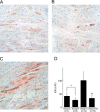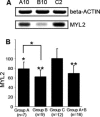Slow cardiac myosin regulatory light chain 2 (MYL2) was down-expressed in chronic heart failure patients
- PMID: 21259275
- PMCID: PMC6652384
- DOI: 10.1002/clc.20832
Slow cardiac myosin regulatory light chain 2 (MYL2) was down-expressed in chronic heart failure patients
Abstract
Background: Genetic studies have shown that many slow cardiac myosin regulatory light chain 2 (MYL2) gene mutations can cause hypertrophic cardiomyopathy, which is one of the most common causes of heart failure (HF). But until now there has been no pathological or histological evidence that MYL2 may be associated with HF development. Recent microarray studies indicated that myosin heavy chain expression changed in the pathological process of HF. Because MYL2 is a regulatory component of myosin heavy polypeptide, the role of MYL2 protein in HF needs to be studied.
Hypothesis: The level of expression of MYL2 may change in the heart tissue of patients with chronic HF.
Methods: We collected 28 human right auricle samples, 16 from chronic HF patients and 12 from healthy control subjects. Immunohistochemistry was carried out to observe the tissue-expression pattern of the MYL2 protein and Western blot methods were performed to quantify the relative MYL2 expression level.
Results: In chronic HF patients, the MYL2 protein level decreased significantly compared with normal controls (t test P < 0.05). Among the 16 HF patients, MYL2 expression in the severe HF group (New York Heart Association [NYHA] class III or IV) was even lower than that of the moderate HF group (NYHA class II) (t test P < 0.05).
Conclusions: MYL2 was down-expressed in HF tissues, and our findings suggested that MYL2 may play a role in the development and progression of chronic HF.
Copyright © 2010 Wiley Periodicals, Inc.
Figures


Comment on
-
The slow cardiac myosin regulatory light chain in heart failure.Clin Cardiol. 2011 Jan;34(1):10-1. doi: 10.1002/clc.20867. Clin Cardiol. 2011. PMID: 21259272 Free PMC article. No abstract available.
References
-
- Task Force for Diagnosis and Treatment of Acute and Chronic Heart Failure 2008 of European Society of Cardiology, Dickstein K, Cohen‐Solal A, et al. ESC Guidelines for the diagnosis and treatment of acute and chronic heart failure 2008: the Task Force for the Diagnosis and Treatment of Acute and Chronic Heart Failure 2008 of the European Society of Cardiology. Developed in collaboration with the Heart Failure Association of the ESC (HFA) and endorsed by the European Society of Intensive Care Medicine (ESICM) [published correction appears in Eur Heart J 2010;12:416]. Eur Heart J 2008; 29: 2388–2442. - PubMed
-
- McMurray JJ, Pfeffer MA. Heart failure. Lancet 2005; 365: 1877–1889. - PubMed
-
- Latronico MV, Elia L, Condorelli G, et al. Heart failure: targeting transcriptional and post‐transcriptional control mechanisms of hypertrophy for treatment. Int J Biochem Cell Biol 2008;40: 1643–1648. - PubMed
-
- Oka T, Komuro I. Molecular mechanisms underlying the transition of cardiac hypertrophy to heart failure. Circ J 2008;72(Suppl A): A13–A16. - PubMed
Publication types
MeSH terms
Substances
LinkOut - more resources
Full Text Sources
Medical
Research Materials
Miscellaneous

